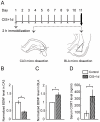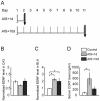Stress leads to contrasting effects on the levels of brain derived neurotrophic factor in the hippocampus and amygdala
- PMID: 22272355
- PMCID: PMC3260293
- DOI: 10.1371/journal.pone.0030481
Stress leads to contrasting effects on the levels of brain derived neurotrophic factor in the hippocampus and amygdala
Abstract
Recent findings on stress induced structural plasticity in rodents have identified important differences between the hippocampus and amygdala. The same chronic immobilization stress (CIS, 2 h/day) causes growth of dendrites and spines in the basolateral amygdala (BLA), but dendritic atrophy in hippocampal area CA3. CIS induced morphological changes also differ in their temporal longevity--BLA hypertrophy, unlike CA3 atrophy, persists even after 21 days of stress-free recovery. Furthermore, a single session of acute immobilization stress (AIS, 2 h) leads to a significant increase in spine density 10 days, but not 1 day, later in the BLA. However, little is known about the molecular correlates of the differential effects of chronic and acute stress. Because BDNF is known to be a key regulator of dendritic architecture and spines, we investigated if the levels of BDNF expression reflect the divergent effects of stress on the hippocampus and amygdala. CIS reduces BDNF in area CA3, while it increases it in the BLA of male Wistar rats. CIS-induced increase in BDNF expression lasts for at least 21 days after the end of CIS in the BLA. But CIS-induced decrease in area CA3 BDNF levels, reverses to normal levels within the same period. Finally, BDNF is up regulated in the BLA 1 day after AIS and this increase persists even 10 days later. In contrast, AIS fails to elicit any significant change in area CA3 at either time points. Together, these findings demonstrate that both acute and chronic stress trigger opposite effects on BDNF levels in the BLA versus area CA3, and these divergent changes also follow distinct temporal profiles. These results point to a role for BDNF in stress-induced structural plasticity across both hippocampus and amygdala, two brain areas that have also been implicated in the cognitive and affective symptoms of stress-related psychiatric disorders.
Conflict of interest statement
Figures



Similar articles
-
Recovery after chronic stress fails to reverse amygdaloid neuronal hypertrophy and enhanced anxiety-like behavior.Neuroscience. 2004;128(4):667-73. doi: 10.1016/j.neuroscience.2004.07.013. Neuroscience. 2004. PMID: 15464275
-
The delayed strengthening of synaptic connectivity in the amygdala depends on NMDA receptor activation during acute stress.Physiol Rep. 2016 Oct;4(20):e13002. doi: 10.14814/phy2.13002. Physiol Rep. 2016. PMID: 27798355 Free PMC article.
-
Stress duration modulates the spatiotemporal patterns of spine formation in the basolateral amygdala.Proc Natl Acad Sci U S A. 2005 Jun 28;102(26):9371-6. doi: 10.1073/pnas.0504011102. Epub 2005 Jun 20. Proc Natl Acad Sci U S A. 2005. PMID: 15967994 Free PMC article.
-
Stress and trauma: BDNF control of dendritic-spine formation and regression.Prog Neurobiol. 2014 Jan;112:80-99. doi: 10.1016/j.pneurobio.2013.10.005. Epub 2013 Nov 6. Prog Neurobiol. 2014. PMID: 24211850 Review.
-
Stress, anxiety, and dendritic spines: what are the connections?Neuroscience. 2013 Oct 22;251:108-19. doi: 10.1016/j.neuroscience.2012.04.021. Epub 2012 Apr 20. Neuroscience. 2013. PMID: 22522470 Review.
Cited by
-
Childhood adversity and epigenetic regulation of glucocorticoid signaling genes: Associations in children and adults.Dev Psychopathol. 2016 Nov;28(4pt2):1319-1331. doi: 10.1017/S0954579416000870. Epub 2016 Oct 3. Dev Psychopathol. 2016. PMID: 27691985 Free PMC article. Review.
-
Dynamic plasticity: the role of glucocorticoids, brain-derived neurotrophic factor and other trophic factors.Neuroscience. 2013 Jun 3;239:214-27. doi: 10.1016/j.neuroscience.2012.08.034. Epub 2012 Aug 23. Neuroscience. 2013. PMID: 22922121 Free PMC article. Review.
-
Hippocampus: Molecular, Cellular, and Circuit Features in Anxiety.Neurosci Bull. 2023 Jun;39(6):1009-1026. doi: 10.1007/s12264-023-01020-1. Epub 2023 Jan 21. Neurosci Bull. 2023. PMID: 36680709 Free PMC article. Review.
-
Dynamic effects of chronic unpredictable mild stress on the hippocampal transcriptome in rats.Mol Med Rep. 2022 Apr;25(4):110. doi: 10.3892/mmr.2022.12626. Epub 2022 Feb 4. Mol Med Rep. 2022. PMID: 35119083 Free PMC article.
-
Effect of Acute Stress on the Expression of BDNF, trkB, and PSA-NCAM in the Hippocampus of the Roman Rats: A Genetic Model of Vulnerability/Resistance to Stress-Induced Depression.Int J Mol Sci. 2018 Nov 24;19(12):3745. doi: 10.3390/ijms19123745. Int J Mol Sci. 2018. PMID: 30477252 Free PMC article.
References
-
- Luine V, Villegas M, Martinez C, McEwen BS. Repeated stress causes reversible impairments of spatial memory performance. Brain Research. 1994;639:167–170. - PubMed
-
- Shors TJ, Weiss C, Thompson RF. Stress-induced facilitation of classical conditioning. Science. 1992;257:537–539. - PubMed
-
- McEwen BS. Stress and hippocampal plasticity. Annual Review of Neuroscience. 1999;22:105–122. - PubMed
-
- Roozendaal B, McEwen BS, Chattarji S. Stress, memory and the amygdala. Nature Review Neuroscience. 2009;10:423–433. - PubMed
Publication types
MeSH terms
Substances
Grants and funding
LinkOut - more resources
Full Text Sources
Other Literature Sources
Medical
Miscellaneous

